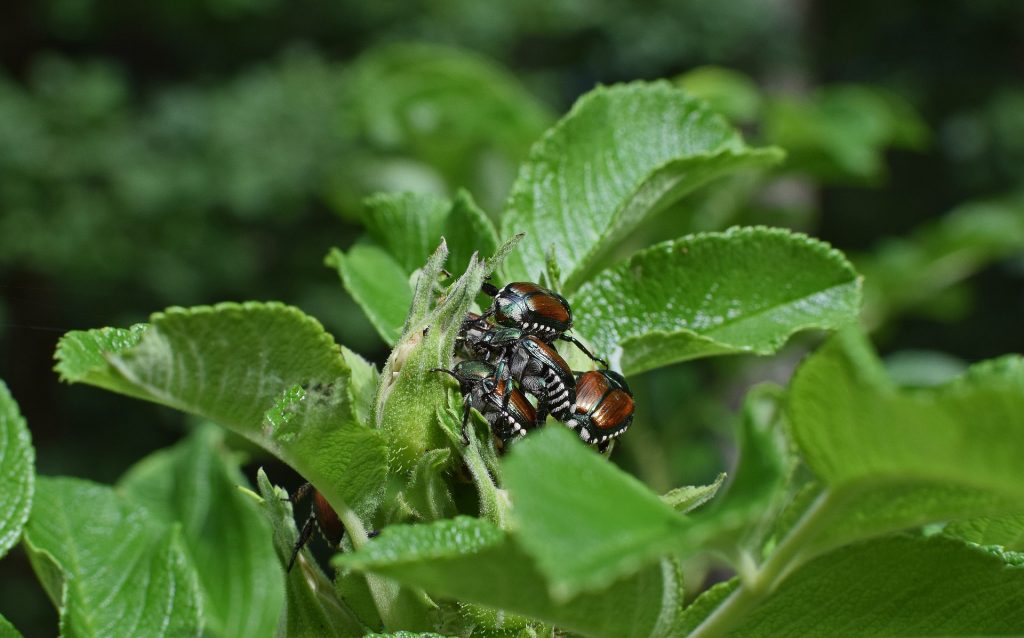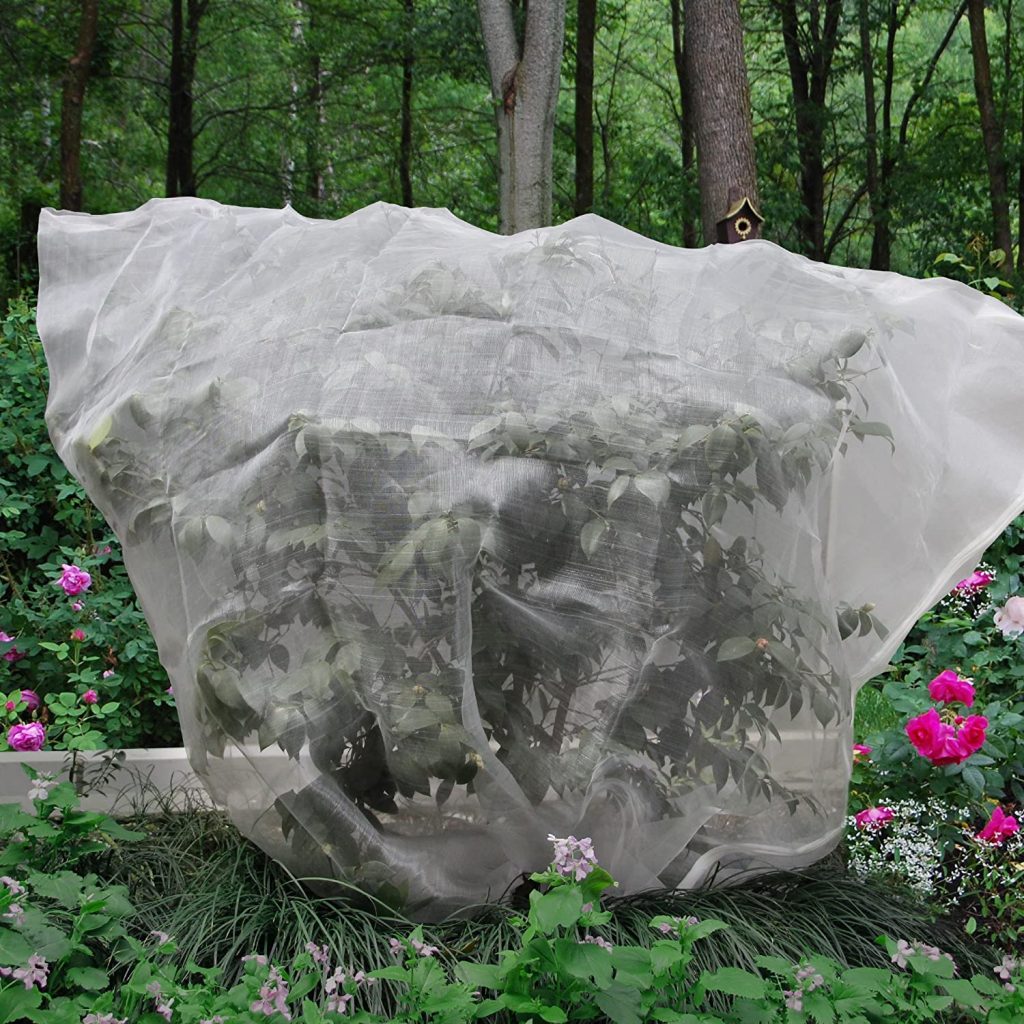The Japanese beetle (Popillia japonica) is an invasive pest in eastern areas of the US. These beetles aren’t necessarily destructive in Japan, as they’re controlled naturally using predatory insects. But, that’s not the case for the U.S.A.
The Japanese beetle is one of the most destructive/damaging pests to landscape, ornamental plants, and turfgrass. You’ve likely seen them copulating in your garden (one of their favorite hobbies when they aren’t eating down your plants), hence your desire to find effective Japanese beetle control methods.
These pests have been known to infest around 300 plant species including birch trees, grapes, and rose bushes. The Japanese beetle larvae, also known as white grubs, typically feed on grassroots, damaging turf in golf courses, lawns, and parks. On the other hand, adult Japanese beetles feed on flowers, foliage, and fruits. The turf and ornamental industry spend a whopping $450 million annually in pest management alone to control Japanese beetles.
With Japanese beetles waging war on your garden and turf, you’re wondering what options there are to prevent your produce from being destroyed. We discuss what methods are used to control the Japanese beetle in the next subheading.

What Methods are Used to Control the Japanese Beetle
If you’re wondering what methods are used to control the Japanese beetle, there are various options. Japanese beetle control methods differ, and so are their effects.
You will need to use different options to control Japanese beetles at different stages. This is whether they are full grown adults, or at their larval stage (at this time they’re identified as grubs) and are more likely to affect turfgrass and not your flowers.
Learn how to get rid of grubs naturally by clicking this link.
For a quick look at what methods are used to control the Japanese beetle, these include physical removal, netting, setting lures and traps, cultural control, using plants that are resistant to Japanese beetles, chemical and biological control.
Side Note: As they do look alike, some homeowners might mistakenly refer to green June beetles as Japanese beetles, as these two beetles are just about active around the same time of the year. While they do look alike, there are significant differences. So, ensure to examine them closely to spot the difference.

Japanese Beetle Control Methods
Now that you have a better understanding of the Japanese beetle and a quick look at what methods are used to control the Japanese beetle, it’s time to dig into the heart of each tactic.
Let’s jump right into the Japanese beetle control methods.
This post contains affiliate links. Please view our full disclaimer.
1. Physical Removal – Handpicking
When beetle numbers are low and have infested only small plantings, one of the most practical Japanese beetle control method is to remove them by hand. If the plant is sturdy enough and damage won’t be inflicted, you could try shaking them off. Ensure to have a container below to trap them in. It makes no sense to shake them off the plant, only to have them re-infest it. You can drop the beetles in soapy water to kill them.
Make it a habit to check your plants every day and handpick beetles when you see one to lessen feeding damage to your plants. Keep in mind that damaged leaves remit chemicals in the air that attracts more beetles to your plants. By removing Japanese beetles physically, you’ll prevent or minimize new beetles from flocking to your ornamentals.
While lady bugs and other beetle types are known to bite, research shows otherwise for the Japanese beetle. However, if you’re scared or doubtful, wear gloves when handpicking.
2. Creating a Physical Barrier – Netting
This Japanese beetle control method is quite simple and effective when used alongside handpicking.
When you use a physical barrier, you are preventing Japanese beetles from further latching on to your plants.
Let’s say you’ve just recently handpicked all the Japanese beetles from your plants. To prevent a re-infestation, simply use a physical barrier. A physical barrier could mean covering your roses with a cheesecloth. Fine netting can also be used.
While this method can prove effective for specific plants, it must be done with care. Plants that are in bloom will require pollination. If you cover up these plants, pollinators won’t be able to get to them. But, there is a workaround to it if you want to use this method. Simply continue handpicking Japanese beetles until your plants have started to set fruit, then you can now cover them with fine netting.

3. Setting Lures and Traps
You can also buy traps from garden centers if you wish to try lures and mechanical traps to eradicate Japanese beetles. There are two types of commercial traps you can choose from. One kind of trap uses a bait that mimics the smell of virgin female beetles, which will highly attract male Japanese beetles. Another trap variant uses bait that has a sweet smell of food type that can attract both males and females. Both types of trap can attract thousands of beetles daily.
While this method of Japanese beetle control might have some success, it could backfire. Some Japanese beetle traps actually capture fewer beetles than those lured, as some beetles tend to fly around the trap. Plus, if these lures and traps are assembled close to gardens and plants beetles are attracted to, more harm than good can be done.
If you do opt to use this Japanese beetle control method, ensure you’re setting up the lure and trap far away from garden and plants.
Traps can also be effective when you use many of them and spread over a certain area.
You must also keep in mind that traps must not stay in place all year long because lures in them get stale. Placing a trap should also be done around June and August, during the flight period of Japanese beetles.
4. Cultural Control
Female Japanese beetles will most likely lay eggs on moist soil since moisture is essential for the survival of eggs, as well as larval development. During the dry season, female beetles will look for irrigated areas to deposit eggs.
You can try suppressing the beetle population by manipulating their habitat and make it less suitable for them. Holding off irrigation may decrease the white grub population. In addition, rotating the soil to at least 3 to 4 inches deep during fall can also lessen the chances of larvae survival.

5. Resistant and Susceptible Plants
As mentioned earlier, Japanese beetles feed on a number of plant species. However, there are some species that they aren’t that interested in. Choosing a Japanese beetle resistant and susceptible plant for your landscape is what you may consider when you want to add new plants. Although this Japanese control method isn’t a treatment, it’s a strong preventative. If you can cultivate crops and plants that they aren’t a fan of, you’ll see them in fewer numbers, if at all.
Plants that are less preferred by Japanese beetles include boxwood, chrysanthemum, clematis, conifers, daylily, geranium, ginkgo, lilac (Japanese tree and common lilac), magnolia, maple (red and silver), oak, and yew.
Side Note: If you have a lot of roses planted in your garden, expect a lot of trouble.
6. Chemical Control
There are several pesticides you can choose from to get rid of Japanese beetles. However, before choosing this method, there are certain factors you need to consider. You need to assess and know the benefits, as well as the risks of using insecticides.
Knowing when and how to apply insecticides is crucial for a successful pesticide application. Remember that pesticides are toxic, so you need to follow carefully and exactly what the label direction says. Improper use of pesticides can lead to serious hazards to both humans and wildlife.
Another risk you should know in using pesticides is the growing concern of water contamination due to pesticide runoff. You can try checking the agricultural chemicals handbook where you’re residing, as each State has its own that’s being updated every year for proper pest control recommendations.
Some of the chemicals you can use for adult Japanese beetles include bifenthrin, carbaryl, cyfluthrin, deltamethrin, and permethrin. On the other hand, imidacloprid, halofenzide, trichlorfon, and chlorantraniliprole are the chemicals you can use for larvae. When treating plants using chemicals, be sure to thoroughly treat flowers and foliage.
Using this Japanese beetle control method in the afternoon when Japanese beetles are usually active will lead to optimal control. Take note that repeated applications may be needed to prevent re-infestation.
Side Note: If you do opt to use pesticides, bear in mind that this can affect beneficial insects such as birds and pollinators.
It’s best to use low-risk pesticides. Products containing pyrethrins are effective, provided they’re sprayed directly on to plants. Do not spray bees and other beneficial insects.
Another option to use is neem oil. You will need to apply regularly for several days for the best result. Although neem oil is a deterrent and may keep Japanese beetle at bay, it’s more difficult to repel them when they infect your garden in large numbers.
Another option to consider is residual insecticides. These have a longer effect when used against Japanese beetles.
A Japanese beetle residual insecticide that provides protection for up to four weeks is chlorantraniliprole (Acelepryn). Plus, this has a low risk to insects like bees. Other options insecticides with the following chemicals:
- Permethrin
- Lambda-cyhalothrin
- Cyfluthrin
- Carbaryl or acephate
- Bifenthrin
7. Biological Control
If you’re not a fan of chemicals, you can try this Japanese beetle control method. Using fungi, nematodes, parasites, and other biological control agents can be a successful way to control beetle population.
Using biological control agents might take some time to take effect as compared to pesticides, but this method lasts longer. Also, it is not harmful to beneficial organisms, unlike pesticides.
Biological pesticides are parasitic in nature and includes Heterorhabditis bacteriophora. These nematodes affect Japanese beetle grubs and need to be applied to the soil when grubs are present.
Another option includes milky spore bacteria (Paenibacillus popilliae, also known as Bacillus popilliae). The milky spore bacteria only affects Japanese beetle grubs, and not beneficial organisms.
Japanese beetles may be small pests, but they can definitely be a big problem. Using various Japanese beetle control methods can help you minimize these pests, and protect your plants, fruits, and ornamentals. Choose the right method, or a combination of Japanese beetle control methods, for your situation and it can help you lessen the damage caused by this pest.
Did you know that the Japanese beetle is oftentimes confused with another beetle with similar features? Learn which beetle that is by reading this article.
Share the Love
If you’ve enjoyed reading this article about different Japanese beetle control methods and found it beneficial to your situation, don’t forget to share.
Sharing our content with friends and family helps to keep the lights going, so that we can continue to help you deal with simple and serious pest problems at home. As usual, we welcome any questions you may have. Please make use of the comments section below.





One comment on “7 Effective Japanese Beetle Control Methods”